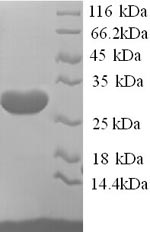Recombinant Human A-type voltage-gated potassium channel KCND2 is produced in a yeast expression system and consists of the 406-630 amino acid region. The protein includes an N-terminal 6xHis-tag for easier purification and detection. SDS-PAGE analysis confirms purity greater than 90%, which appears to provide high-quality material for research applications. This product is intended for research use only.
KCND2 belongs to the voltage-gated potassium channel family and likely plays a critical role in regulating membrane potential and electrical signaling in cells. It seems to be primarily involved in the repolarization phase of the cardiac action potential, potentially influencing heart rhythm and neuronal excitability. These characteristics make KCND2 an important focus of research for understanding cardiac and neurological functions.
Potential Applications
Note: The applications listed below are based on what we know about this protein's biological functions, published research, and experience from experts in the field. However, we haven't fully tested all of these applications ourselves yet. We'd recommend running some preliminary tests first to make sure they work for your specific research goals.
Based on the provided information, the folding state and bioactivity of this recombinant KCND2 protein fragment are unknown and must be considered highly uncertain. KCND2 is a voltage-gated potassium channel whose function depends on the correct assembly of transmembrane domains and a complex cytoplasmic structure. This recombinant human KCND2 protein is only a fragment corresponding to part of the cytoplasmic domain (406-630aa), expressed in yeast with an N-terminal His-tag. While yeast is a eukaryotic system, it may not provide the specific chaperones or environment needed for the correct folding of this mammalian ion channel domain. The fragment lacks the transmembrane regions critical for the channel's overall structure. Applications relying on specific biological interactions or ligand binding are speculative without the validation of the recombinant KCND2 protein's folding and activity.
1. Antibody Development and Validation
This recombinant KCND2 fragment is suitable for use as an immunogen to generate antibodies specific to this region of the human KCND2 protein. The high purity (>90%) and the His-tag for purification make it practical for immunization and screening. However, it is critical to understand that the antibodies generated will be against the linear epitopes of this isolated cytoplasmic fragment. Their ability to recognize the natively folded, full-length KCND2 channel in the neuronal membrane is uncertain and must be rigorously validated using native tissue or full-length KCND2 protein. These antibodies are best suited for techniques like Western blotting against denatured samples.
2. Protein-Protein Interaction Studies
The His-tagged recombinant KCND2 fragment can be immobilized for pull-down assays. However, the utility for discovering biological interaction partners is severely limited. The cytoplasmic domain's interactions (e.g., with KChIPs or DPPXs) are highly conformation-specific. Only if this recombinant KCND2 fragment is correctly folded, the cytoplasmic domain's interactions (e.g., with KChIPs or DPPXs) will be valid. Otherwise, it is not recommended for mapping authentic regulatory networks.
3. Biochemical Characterization and Biophysical Analysis
This purified recombinant KCND2 protein fragment is well-suited for basic biochemical and biophysical characterization. Techniques like dynamic light scattering, circular dichroism spectroscopy, and thermal stability assays can provide insights into the aggregation state, secondary structure, and stability of this specific polypeptide fragment. This application is valid as it focuses on the intrinsic physical properties of the purified recombinant KCND2 protein, independent of its native bioactivity.
Final Recommendation & Action Plan
The unequivocal recommendation is to restrict the use of this protein lot to Applications 1 (antibody development with limitations) and 3 (biophysical characterization of the recombinant KCND2 fragment itself). For any functional studies related to KCND2 (interactions, drug screening), a different reagent is essential. This would require expression of the full-length channel, or at least a construct containing the pore-forming domains, in a system suitable for membrane protein production (e.g., mammalian, insect, or cell-free systems with lipids). The immediate step for any future functional work is to validate channel activity (e.g., by electrophysiology) before pursuing interaction or screening studies.






